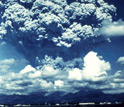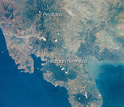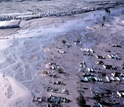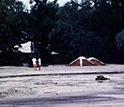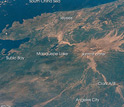News Release 10-209
Volcanic Eruptions Affect Rainfall Over Asian Monsoon Region
Some regions drier, others wetter
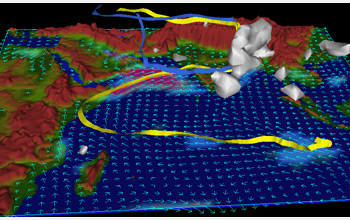
Volcanic eruptions may affect Asian monsoon rainfall; the seasonal storms water critical crops.
November 4, 2010
This material is available primarily for archival purposes. Telephone numbers or other contact information may be out of date; please see current contact information at media contacts.
Scientists have long known that large volcanic explosions can affect the weather by spewing particles that block solar energy and cool the air.
Some suspect that extended "volcanic winters" from gigantic eruptions helped kill off dinosaurs and Neanderthals.
In the summer following Indonesia's 1815 Tambora eruption, frost wrecked crops as far away as New England, and the 1991 blowout of the Philippines' Mount Pinatubo lowered average global temperatures by 0.7 degrees F--enough to mask the effects of greenhouse gases for a year or so.
Now, in research funded by the National Science Foundation (NSF)'s Division of Atmospheric and Geospace Sciences, scientists have discovered that eruptions also affect rainfall over the Asian monsoon region, where seasonal storms water crops for nearly half of Earth's population.
Tree-ring researchers at Columbia University's Lamont-Doherty Earth Observatory (LDEO) showed that big eruptions tend to dry up much of Central Asia, but bring more rain to southeast Asian countries including Vietnam, Laos, Cambodia, Thailand and Myanmar--the opposite of what many climate models predict.
A paper reporting their results appears in an advance online version of the American Geophysical Union (AGU) journal Geophysical Research Letters.
The growth rings of some tree species can be correlated with rainfall. LDEO's Tree Ring Lab used tree rings from some 300 sites across Asia to measure the effects of 54 volcanic eruptions going back about 800 years.
The data came from LDEO's new 1,000-year tree-ring atlas of Asian weather, which has produced evidence of long, devastating droughts.
"We might think of the solid Earth and the atmosphere as two different things, but everything in the system is interconnected," said Kevin Anchukaitis, the paper's lead author. "Volcanoes can be important players in climate over time."
Large explosive eruptions send up sulfur compounds that turn into tiny sulfate particles high in the atmosphere, where they deflect solar radiation.
The resulting cooling on Earth's surface can last for months or years.
Not all eruptions have that effect, however. For instance, the continuing eruption of Indonesia's Merapi this fall has killed dozens, but this latest episode is probably not big enough by itself to effect large-scale weather changes, scientists believe.
As for rainfall, in the simplest models, lowered temperatures decrease evaporation of water from the surface to the air. Less water vapor translates to less rain.
But matters are greatly complicated by atmospheric circulation patterns, cyclic changes in temperatures over the oceans, and the shapes of land masses.
Until now, most climate models incorporating changes in the sun and the atmosphere have predicted that volcanic explosions would disrupt the monsoon by bringing less rain to southeast Asia--but the researchers found the opposite.
They studied several eruptions, including one in 1258 from an unknown tropical site, thought to be the largest of the last millennium; the 1600-1601 eruption of Peru's Huaynaputina; Tambora in 1815; the 1883 explosion of Indonesia's Krakatau; Mexico's El Chichón in 1982; and Pinatubo.
Tree rings showed that huge swaths of southern China, Mongolia and surrounding areas consistently dried up in the year or two following big events, while mainland southeast Asia received increased rain.
The researchers believe there are many possible factors involved.
"The data only recently became available to test the models," said Rosanne D'Arrigo, one of the paper's co-authors. "There's a lot of work to be done to understand how all these different forces interact."
In some episodes pinpointed by the study, it appears that strong cycles of the El Niño-Southern Oscillation, which drives temperatures over the Pacific and Indian Oceans and is thought to strongly affect the Asian monsoon, might have counteracted eruptions, lessening their drying or moistening effects. p>
But it could work the other way, too, said Anchukaitis; if atmospheric dynamics and volcanic eruptions come together with the right timing, they could reinforce one another--with drastic results.
"Then you get flooding or drought, and neither flooding nor drought is good for the people living in those regions," he said.
Ultimately, said Anchukaitis, such studies should help scientists refine models of how natural and man-made forces might act together to shift weather patterns--a vital question for all areas of the world.
-NSF-
-
An 18-kilometer-high plume from one of a series of eruptions in 1991 at Mount Pinatubo.
Credit and Larger Version -
In 1982, Mount Pinatubo was a forested peak with extensive rice fields at its base.
Credit and Larger Version -
The village of Lourdes near Mount Pinatubo, was inundated by mudflows of volcanic debris.
Credit and Larger Version -
After Pinatubo's eruption, this house was buried by a mudflow of volcanic ash and debris.
Credit and Larger Version -
In 1992, a year after Pinatubo's eruption, its summit is blasted away and forests blown down.
Credit and Larger Version
Media Contacts
Cheryl Dybas, NSF, (703) 292-7734, email: cdybas@nsf.gov
Kevin Krajick, LDEO, (212) 854-9729, email: kkrajick@ei.columbia.edu
Peter Weiss, AGU, (202) 777-7507, email: pweiss@agu.org
The U.S. National Science Foundation propels the nation forward by advancing fundamental research in all fields of science and engineering. NSF supports research and people by providing facilities, instruments and funding to support their ingenuity and sustain the U.S. as a global leader in research and innovation. With a fiscal year 2023 budget of $9.5 billion, NSF funds reach all 50 states through grants to nearly 2,000 colleges, universities and institutions. Each year, NSF receives more than 40,000 competitive proposals and makes about 11,000 new awards. Those awards include support for cooperative research with industry, Arctic and Antarctic research and operations, and U.S. participation in international scientific efforts.
Connect with us online
NSF website: nsf.gov
NSF News: nsf.gov/news
For News Media: nsf.gov/news/newsroom
Statistics: nsf.gov/statistics/
Awards database: nsf.gov/awardsearch/
Follow us on social
Twitter: twitter.com/NSF
Facebook: facebook.com/US.NSF
Instagram: instagram.com/nsfgov

